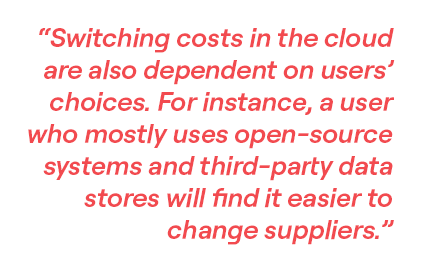Cloud computing is changing the way the world stores and processes information, enabling the rise of artificial intelligence (AI) and the Internet of Things. The growth of this new industry is another step in the ‘platformization’ of the digital economy, says Jacques Crémer, raising important questions for cutting-edge research hubs such as TSE Competition Policy and Regulation Center. In a new report, he and his co-authors Gary Biglaiser at University of North Carolina and Andrea Mantovani from TBS Education warn that policymakers must be guided by economic analysis as they venture into this nebulous landscape.
How is the cloud driving the digital revolution?
By leveraging distributed networks, cloud computing allows convenient, on-demand access over the internet to servers, storage, databases, networks, software, and data analytics. Firms now also increasingly use computing services designed to work directly on the cloud, without needing to manage the underlying software. Cloud providers can quickly and easily allocate these resources, managing fluctuations in demand with little human interaction.
The economic impact of cloud storage and processing capabilities is already profound, boosting innovation, productivity, and the operational agility of the public sector. Telecom providers benefit from automation and seamless implementation of updates; broadcasters can now operate across diverse delivery networks, formats, and viewing devices.
Saving money on computing capacity and services also improves competition by lowering entry costs. Startups especially benefit from the cloud’s scalability and flexibility. Recent studies find that the adoption of cloud services leads to more employment and revenue, especially for young firms, as well as improved energy efficiency.
Thanks to 5G/6G, cloud computing is expected to merge with telecommunications in an interconnected universe overflowing with data. Such developments will continue to spur the development of AI and the Internet of Things, which refers to the networking of devices such as smartphones and self-driving cars. Without the cloud’s computational power, OpenAI would not have developed its foundation models and ChatGPT.
Who are the main players?
Amazon was quick to realize it could profitably rent its unused computing capacity to other firms. Launched in 2006, Amazon Web Services (AWS) remains the world’s largest cloud provider with 32% of the market. Since 2010, Microsoft's Azure has caught up quickly to gain a 23% market share, followed by Google Cloud Platform (GCP) on 11%. AWS tends to be favored by small businesses and start-ups; Azure by larger, more established firms. Revenue for cloud services between 2021 and 2022 reached $191 billion, and this market is projected to be worth $376 billion by 2029.
European providers are relatively small, and their market share is decreasing. The EU recently supported European cloud leader OVHcloud with a €200 million loan and assistance in building 15 new data centers by the end of 2024.
Specialized cloud services could be an entry point for future competitors. Currently, data management tools are offered by both cloud providers and independent firms, such as Snowflake or Databricks. CoreWeave is a provider that specializes in large-scale computations, as required for AI models and video rendering.
Why are competition authorities concerned?
Cloud computing poses delicate challenges for policymakers, whose concerns tend to focus on the dominance of cloud providers and their impact on switching costs and interoperability. Despite the recent entry of new players, the market share of the Big Three (AWS, Azure and GCP) increased from 50% in 2017 to 66% in 2023. Coupled with their high levels of profitability, this suggests competition is limited. In response, the European Data Act (2023) has imposed various obligations on cloud providers to promote competition.
But regulators should not rush to intervene as the cloud industry is not yet well understood. Given the technology of the cloud, with substantial fixed costs, a high degree of concentration is to be expected. How much competition is possible? How can it be increased? Does concentration create systemic risks? How should the tools of competition policy be applied? What impact will they have on innovation?
How can economics help to guide regulators?
Policy decisions must be informed by the best possible evidence, using the most appropriate economic tools. Cloud providers behave in many ways as platforms, which have been extensively analyzed over the past four decades. This has given economists an impressive set of tools that can now be adapted to study the cloud.

Evaluation of competition in the cloud sector is difficult, given the nature of the sector, and the very rapid changes it has incurred. Its oligopolistic nature can be explained by many factors common to other digital industries. These include substantial fixed costs required to enter the market, increasing returns to scale, the industry's high level of technicality, and switching costs.
The largest cloud platforms also benefit from network effects, which occur when the value of a service is increased by the presence of more users. There are direct network effects in the cloud: in some cases, it may be easier for two firms which use the same cloud service provider to share data. There are “indirect” network effects: it is easier to find engineers trained for the use of the most popular clouds.
What’s peculiar about cloud pricing?
Unlike traditional IT services, cloud services are priced based on a pay-as-you-go model in which users are charged according to the amount of computations and storage that they use. The pricing tends to be very complex and requires care and professionalism from users who want to control their costs.
Egress fees have received much regulatory attention, despite the fact that they are a very small share of the total cost for cloud users. Egress fees are the charges that users must pay to move their data out of their cloud service provider. They have been criticized as anti-competitive. The critics fear that they discourage switching between service providers, increasing the risk of “lock in” for customers who fail to anticipate future needs and making entry of new providers more difficult.
Europe’s Data Act will soon ban switching charges when cloud customers migrate to a new service, including egress fees above the cost of providing the service. The UK regulator Ofcom indicates that the Big Three’s egress fees are 5-10 times higher than smaller rivals. However, serious economic analysis is necessary before concluding definitely that egress fees are anti-competitive.
Discounts are also widely offered to large customers who spend a predetermined amount, helping cloud providers to forecast demand and invest appropriately in infrastructure. This practice has also been accused of restricting competition. Along with cloud credits, which allow customers to trial cloud resources, regulators fear that discounts encourage the use of a single provider and limit entry by smaller players.
What are some other key issues?
In an open, sustainable digital ecosystem, users should be able to seamlessly switch to services of the highest quality or to lower priced services. To this end, it is vital to improve interoperability, which involves repeated communication between different providers’ services, and portability, which refers to a one-time transfer of a user’s data, applications and workloads to another supplier.
Switching cloud providers can be costly and difficult. In addition to monetary costs, firms may be obliged to adapt production processes and retrain employees. Providers can affect switching costs by adjusting their technologies’ compatibility and adherence to public standards. They can also offer tools and software to ease migration to their own platform. However, switching costs in the cloud are also dependent on users’ choices. For instance, a user who mostly uses open-source systems and third-party data stores will find it easier to change suppliers and leverage cheaper access.
Amazon, Google and Microsoft are large contributors to open-source technology like Kubernetes. This can promote standardization and compatibility. It could also be an instrument for collusion, but we have seen no indication that this is the case. Support for existing industry standards and open-source software may not only help improve their availability and quality but also improve interoperability and portability. However, standards create many trade-offs.
FURTHER READING ‘The Economics of the Cloud’ is coauthored by Gary Biglaiser and Andrea Mantovani. Along with other publications by Jacques Crémer, this working paper is available to read on the TSE website.
Article published in TSE Reflect, September 2024






